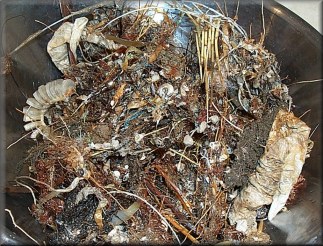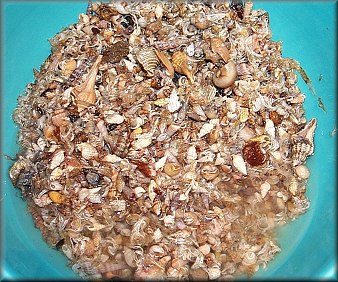
On April 24th of this year my son
Brian was surf fishing for Whiting at Katherine Hanna Park in
Atlantic Beach, Florida. He felt something pulling on his line
and reeled in a discarded fishing rig entangled with algae, dead
sea whips, marsh grass, a large parchment worm, sponges, and an
empty whelk egg case. This "biomass" was teeming with a
zillion (his description) hermit crabs in miniature shells.
Recognizing several species of Epitonium, he
put the tangle in his bucket, added seawater, and went home to
call and tell me what he had for me. I was on my way to give a
shell program to senior citizens, and it was several hours before
I could pick up the bucket; consequently the hermit crabs expired.
First glance told me it would be worthwhile to examine the shells
more closely.
Once
home I photographed the "catch," and then came the task
of removing the hermit bodies from the shells. I found the "panning
for gold" method to be the most successful. With water
running into the bowl with the shells, most of the hermit crab
bodies, being less dense than the shells, washed out and over the
bowls rim.
I
identified the hermit crabs as Pagurus longicarpus Say, 1817, a small and plentiful crab along our
coast. Its well-developed soft and somewhat coiled abdomen is
inserted into a dead mollusk shell it carries around as portable
protection.
I
noticed large numbers of Phrontis acuta (Say, 1822),
the Sharp Nassa, so I thought it would be interesting to
compare the numbers of different species to come up with a count. Phrontis acuta is a small 8-12 mm. species
that has a glossy sturdy structure with strong pointed beads on
the whorls. The beads occasionally have a narrow brown spiral
line connecting them. Dr. Harry G. Lee was excited to hear about
the catch and offered to identify all of the shells (see the list
with identification and shell counts at the end of article). At
final count, I recorded an amazing 3,952 shells with 2,088 being Phrontis
acuta for 53% of the total. The 1,864 other shells
were distributed among 59 different species.
Why
so many Phrontis acuta? The family
Nassariidae, the mud snails, are shallow water, usually
intertidal dwellers. They occur in large colonies and are
scavengers. Several months ago I witnessed a closely related Nassarius
species of the Indo-Pacific in the surf at Nuku Hiva Island in
the Marquesas. This mollusk was very active in the surf zone.
Each wave would pick up the tiny snail several feet off of the
bottom where it would use its mantle to maneuver/glide to the
bottom to feed again. There must have been thousands in an area
of about five square meters. I can only surmise that locally Phrontis
acuta has the same habit and is a lot more common in
our surf than I had originally thought.
 The
question also arises as to why so many hermit crabs were on the
biomass entanglement. What are the gains of coexistence - food,
protection, reproduction? We do know that some hermit crabs like
the company of their peers. Any shell collector can tell of
turning a rock and finding hundreds of hermits "hanging out
together." The mass could also have been a "lunch wagon"
on which the hermits could hitch a ride and feed as it rolled
along the bottom. The
question also arises as to why so many hermit crabs were on the
biomass entanglement. What are the gains of coexistence - food,
protection, reproduction? We do know that some hermit crabs like
the company of their peers. Any shell collector can tell of
turning a rock and finding hundreds of hermits "hanging out
together." The mass could also have been a "lunch wagon"
on which the hermits could hitch a ride and feed as it rolled
along the bottom.
Some live shells were found on the mass.
These included Astyris lunata,
Lunarca ovalis, Anadara
transversa and Musculus
lateralis. Also, two fossil species were
identified - Carditamera arata
(Conrad, 1832) and Gemophos lymani
(M. Smith, 1936). There were quite a few single shells of
bivalves in the entanglement.
One week later I called Brian to tell him he
was right about the Epitonium,
that there were eight species identified,
and that the total number of shells in the catch was 3,952. His
reply was, "Wow, - Mom just think how many jumped or fell
off when I was reeling it in!"
Below is a listing of shells and the number
of each species obtained from the tangle of tackle, seagrass, Busycon
eggcase, etc., angled by Brian Lloyd and lent to H. G. Lee on 4/27/00:
- 1 Nucula proxima
Say, 1822 Atlantic Nutclam
- 3 Brachidontes exustus
(Linnaeus, 1758) Scorched Mussel
- 11 Musculus lateralis
(Say, 1822) Lateral Mussel
- 17 Anadara transversa
(Say, 1822) Transverse Ark
- 1 Carditamera arata (Conrad,
1832) fossil
- 3 Lunarca ovalis (Bruguière, 1789) Blood Ark
- 1 Pleuromeris tridentata
(Say, 1826) Threetooth Carditid
- 1 Crassinella dupliniana
(Dall, 1903) Pointed Crassinella
- 13 Mulinia lateralis
(Say, 1822) Dwarf Surfclam
- 1
Ameritella versicolor
(DeKay, 1843) Many-colored Tellin
- 1 Donax fossor
Say, 1822 Fossor Coquina
- 2 Donax variabilis Say,
1822 Variable Coquina
- 3 Abra aequalis
(Say, 1822) Atlantic Abra
- 1 Dosinia discus
(Reeve, 1850) Disk Dosinia
- 1 Sphenia dubia
(H. C. Lea, 1843) Dubious Sphenia
- 1 Litiopa melanostoma Rang,
1829 Sargassum Snail
- 1 Vermicularia knorrii (Deshayes,
1843) Florida Wormsnail
- 3 Littoraria irrorata
(Say, 1822) Marsh Periwinkle
- 1 Caecum antillarum
Carpenter, 1857 Antillean Caecum
- 1 Strombus alatus
Gmelin, 1791 Florida Fighting Conch
- 3 Crepidula atrasolea
Collin, 2000 Blackfoot Slippersnail
- 51 Neverita duplicata
(Say, 1822) Shark Eye
- 431 Tectonatica pusilla
(Say, 1822) Miniature Moonsnail
- 9 Epitonium sp.
aff. albidum (d’Orbigny,
1842) cf. Bladed Wentletrap
- 16 Epitonium angulatum
(Say, 1831) Angulate Wentletrap
- 1 Epitonium championi
Clench and Turner, 1952 Champion’s Wentletrap
- 6 Epitonium humphreysii (Kiener,
1838) Humphrey's Wentletrap
- 3 Epitonium multistriatum
(Say, 1826) Many-ribbed Wentletrap
- 1 Epitonium novangliae (Couthouy, 1838) New England Wentletrap
- 7 Epitonium sp.
aff. worsfoldi Robertson, 1994 cf.
Worsfold's Wentletrap
- 22 Gyroscala rupicola
(Kurtz, 1860) Brown-band Wentletrap
- 2 Melanella conoidea (Kurtz
and Stimpson, 1851) Conoidal Eulima
- 4 Melanella hypsela
(A. E. Verrill and Bush, 1900) Sharp Eulima
- 47 Eupleura caudata
(Say, 1822) Thick-lip Drill
- 34 Urosalpinx cinerea
(Say, 1822) Atlantic Oyster Drill
- 1 Gemophos lymani
(M. Smith, 1936) fossil
- 5
Gemophos tinctus
(Conrad, 1846) Tinted Cantharus
- 38 Busycon carica
(Gmelin, 1791) Knobbed Whelk
- 2
Busycon perversum (Linnaeus, 1758) Lightning Whelk
- 8 Busycotypus canaliculatus
(Linnaeus, 1758) Channeled Whelk
- 21 Ilyanassa obsoleta
(Say, 1822) Eastern Mudsnail
- 133 Ilyanassa trivittata
(Say, 1822) Threeline Mudsnail
- 2088 Phrontis acutus
(Say, 1822) Sharp Nassa
- 6 Cinctura hunteria
(G. Perry, 1811) Eastern Banded
Tulip
- 269 Astyris lunata
(Say, 1826) Lunar Dovesnail
- 17 Costoanachis avara
(Say, 1822) Greedy Dovesnail
- 1 Costoanachis translirata (Ravenel,
1861) Well-ribbed Dovesnail
- 323 Parvanachis obesa
(C. B. Adams,1845) Fat Dove Shell
- 92 Olivella mutica
(Say, 1822) Variable Dwarf Olive
- 22 Olivella
species
- 7 Neoterebra concava (Say,
1826) Concave Auger
- 161 Neoterebra dislocata
(Say, 1822) Eastern Auger
- 1 Neoterebra protexta
(Conrad, 1846) Fine-ribbed Auger
- 1 Cryoturris dorvilliae
(Reeve, 1845) Dorvill’s Mangelia
- 5 Kurtziella limonitella
(Dall, 1884) Punctate Mangelia
- 4 Rubellatoma rubella
(Kurtz and Stimpson, 1851) Reddish Mangelia
- 1 Boonea impressa
(Say, 1822) Impressed Odostome
- 1 Turbonilla (Pyrgiscus)
wrightsvillensis E. Powell, 1981
Carolina Turbonille
- 40 Acteon candens
Rehder, 1939 Rehders Baby-bubble
- 1 Cylichnella bidentata
(d’Orbigny, 1841) Two-tooth Barrel-bubble
|

 The
question also arises as to why so many hermit crabs were on the
biomass entanglement. What are the gains of coexistence - food,
protection, reproduction? We do know that some hermit crabs like
the company of their peers. Any shell collector can tell of
turning a rock and finding hundreds of hermits "hanging out
together." The mass could also have been a "lunch wagon"
on which the hermits could hitch a ride and feed as it rolled
along the bottom.
The
question also arises as to why so many hermit crabs were on the
biomass entanglement. What are the gains of coexistence - food,
protection, reproduction? We do know that some hermit crabs like
the company of their peers. Any shell collector can tell of
turning a rock and finding hundreds of hermits "hanging out
together." The mass could also have been a "lunch wagon"
on which the hermits could hitch a ride and feed as it rolled
along the bottom.